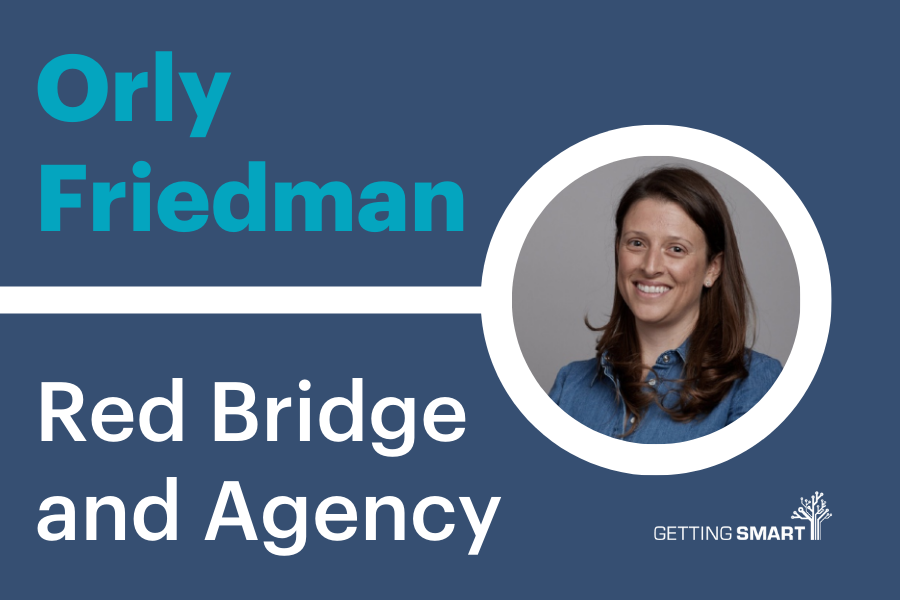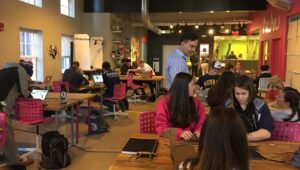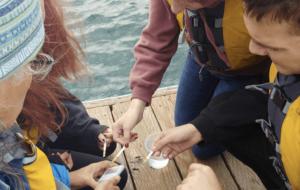Orly Friedman on Red Bridge School and Educating for Agency
Key Points
-
Grouping is based on autonomy levels rather than grade levels and students move forward based on their own decision. This autonomy level is decoupled from academics.
-
Compliance vs Agency – Agency is what young people really need for the future.

Are you interested in attending one of the field’s largest gatherings of K-12 education innovators? The Aurora Institute Symposium 2023 promises community, lessons about education innovation from the field, and the latest research and policy to support education transformation. Find out more here.
On this episode of the Getting Smart Podcast Nate McClennen is joined by Orly Friedman Head of School at Red Bridge in San Francisco, a unique learning environment that builds agency in young people. Orly has worked in the DC public schools, Khan Lab School and with Transcend – among many other experiences. We had the chance to catch up with her at ASU-GSV and she was excited to share the story of the school.
Nobody ever washed a rented car. If you’re going to care of something, you need to feel a sense of ownership of it.
Orly Friedman
Transcript
Nate McClennan: You’re listening to the Getting Smart podcast, and I am Nate McClennan. It feels like the microschool revolution has happened fast. Everybody is talking about the pros and cons and how to scale models that improve outcomes for young people. While homeschool cooperatives, small boutique schools, and one-room schoolhouses have been around for a very long time, recent state legislation allowing money to follow learners to their choice of learning experiences, combined with pandemic-driven learning shifts, has accelerated this movement. We’re seeing a lot of innovation around learning models right now.
Personally, I think the overarching outcomes of education should include agency, a love of learning, physical and mental well-being, and well-developed skills to thrive and engage in the workplace and community. I feel like this is a shared vision by many, yet it’s challenging to implement well. Every educator knows that one size does not fit all. The question is: are we beginning to identify a set of features for schools and learning environments that maximize human growth and potential for every single student, not just some?
To reach these outcomes—such as agency and essential skills—I believe personalized learning and mastery-based approaches are at the heart of the solution. I’m always excited to learn from innovators who are building new school models and not only helping young people they serve but perhaps helping us all discover the set of approaches that best support a positive and vibrant future for the world. Today, I’m thrilled to be joined by one of these innovators, Orly Friedman, the Head of School at Redbridge in San Francisco, a unique learning environment that builds agency in young people. Orly has worked in DC public schools, Khan Lab School, and with Transcend, among other experiences. Orly, I’m excited to talk about Redbridge today.
Orly Friedman: Thanks for having me, Nate. I’m excited to be here.
Nate McClennan: Great. I’m always interested in people’s stories, so let’s start with yours. What influences or experiences have driven you on your path to leading an innovative school in San Francisco?
Orly Friedman: Definitely. One story I tell when talking about our school with prospective parents is about learning violin when I was younger. When I was about four years old, my mom said, “You should learn to play an instrument. You choose which one.” I chose the violin. I learned to play, practiced regularly, went to recitals, and joined our school orchestra. I kept up with it until around seventh grade. But at that point, I wanted to do other things after school more than sit around practicing violin.
Every night after dinner, my mom would say, “It’s time to practice violin,” and I’d drag my feet. We’d get into arguments; it was this daily source of tension. Finally, my mom said, “If you’re not going to practice on your own, then I’m not going to pay for lessons.” That was the first time I had to think about whether I was doing violin for myself or my parents. I reflected on it for a week and realized that I actually did enjoy playing in the orchestra, I was proud of those recitals. From that point on, I decided violin was for me, and my mom never had to ask me to practice again. I continued playing throughout high school.
For me, that’s what giving students agency over their learning means—helping them realize that they are the ones who should be in control of their learning and care about it the most. This is the ethos behind Redbridge, a school designed to reinforce and support student agency. Everyone has a story like this. Often, it’s in college when people are first asked, “What do you care about? What’s important to you?”
Nate McClennan: I love it. It’s beautiful. We’re talking a lot about agency at Getting Smart, and I hear it as a buzzword in many portraits of graduates and similar discussions. But rarely have I seen it embedded into a school’s mission. You’ve put agency, the development of agency, front and center in your mission. So you must have a clear definition. Could you share what agency looks like for you?
Orly Friedman: Yes, agency is such a buzzword. We define it specifically as the ability to set meaningful goals and have the will and skill to achieve them. This definition comes from the research of Albert Bandura, a professor at Stanford, who studied human agency. We took the features of human agency that he researched and adapted them into a definition that applies to schools.
Nate McClennan: Got it—meaningful goals and the will to achieve them. In a school model like Redbridge, it’s easy to see if a student is setting a goal—they can articulate it, and you can observe whether they follow through. But how do you assess the “will” part? That seems challenging to gauge.
Orly Friedman: Yes, the will and skill part is essential. In addition to giving students opportunities to set goals, make plans, and reflect on them throughout the day, we’ve developed a curriculum around what we call “work habits.” Work habits are the executive function skills needed to follow through on a plan to achieve one’s goals. Our work habit curriculum is divided into eight categories, including skills like time management, goal management, focus, initiative, collaboration, and self-knowledge, among others. Each category includes skills specific to students’ levels.
Nate McClennan: So these work habits are ways to measure agency—the skills that allow someone to develop agency, right? If the end goal is for a student to feel they have agency, these skills are part of that. Did you start the school with these work habits, or were they added on later?
Orly Friedman: These work habits began at my previous role at Khan Lab School in Mountain View. I was part of the founding team there, and we observed that while some students advanced quickly with tools like Khan Academy, others plateaued or didn’t take to it, and it wasn’t related to academic ability. It came down to these work habits—whether they could manage time, set short-term goals, understand when they “got it,” or know how to ask for help. So we started developing a curriculum to teach these habits. When we launched Redbridge, I knew that we wanted to make work habits a central part of our curriculum. So, we embedded it into the core of what we do, and we assess students on these work habits. They get feedback on these skills just like they would on academic subjects. We have a structured way to ensure that students are continually reflecting on and improving their work habits.
Nate McClennan: That’s great. I think that’s what’s often missing in schools. There’s a lot of focus on academic content, but not enough on the skills needed to actually apply that knowledge in real life. Could you walk us through how a typical day at Redbridge looks and where these work habits fit into the day?
Orly Friedman: Sure. Our day is divided into three main blocks: Morning Meeting, Core Instruction, and Project Time. We start each day with a Morning Meeting, where students gather in a circle to set their goals and intentions for the day. They share something they’re working on, set a goal, or express a challenge they’re facing. This is a chance to build community, practice public speaking, and think about their goals for the day.
Then we move into Core Instruction, where students work on literacy, math, and other core subjects. During this time, they have individual work plans tailored to their level, and they set specific learning goals within those subjects. Teachers guide them, but students have a lot of control over their learning. They’re learning to make choices, manage time, and focus on their personal goals within their work plans.
The afternoon is dedicated to Project Time. This is when students work on long-term projects that integrate multiple subjects and allow them to apply their skills. Projects are a big part of what we do because they give students a chance to work through complex problems, collaborate with peers, and see how their academic skills apply to real-world challenges. We end the day with a Closing Circle where students reflect on their progress, talk about what went well, and identify areas for improvement.
Nate McClennan: It sounds like you’re helping students develop a reflective practice, which is essential for personal growth. Can you give an example of a project that students might work on during Project Time?
Orly Friedman: Definitely. One example is our “Redbridge Restaurant” project. In this project, students work together to create a restaurant, from concept to execution. They start by brainstorming and deciding on a theme for their restaurant. They then develop a menu, handle budgeting, design the layout, and even make a marketing plan. They calculate costs, work on recipes, and eventually invite families to dine in their restaurant, with the students serving as the staff.
This project integrates math, literacy, social studies, and art, while also developing teamwork, communication, and organizational skills. It’s a great way for students to see how their work in different subjects can come together in a real-world application. They get to experience what it’s like to set a long-term goal, face challenges along the way, and achieve something they’re proud of.
Nate McClennan: That sounds fantastic. I imagine there are a lot of opportunities for students to develop resilience and persistence, especially when things don’t go as planned. How do you handle situations where students encounter failure or setbacks?
Orly Friedman: We encourage students to see setbacks as part of the learning process. We emphasize a growth mindset and help students understand that challenges are opportunities for growth. For example, if something doesn’t work out in a project, we guide students to ask, “What can I learn from this?” rather than focusing on the setback itself. Teachers and students work together to brainstorm solutions, and we often use these moments to reinforce work habits like problem-solving and initiative.
One specific strategy we use is called “Fail Forward.” After a project or an assignment, we ask students to reflect on what didn’t go well and think about how they could approach it differently next time. This practice normalizes failure as a step in the learning process and helps students build resilience.
Nate McClennan: I love that. “Fail Forward” is such a powerful concept. It’s a great way to show students that it’s okay to make mistakes as long as they’re learning from them. Shifting gears a bit, what has the response been like from parents? How do they feel about this approach to education?
Orly Friedman: Parents have been very supportive. They appreciate that Redbridge focuses on both academic and personal growth. Many parents tell us that they see a difference in their children’s confidence, independence, and love for learning. It’s been especially rewarding to hear that students are excited to come to school each day and that they feel ownership over their learning.
We also work closely with parents to help them understand our approach. We hold regular family meetings, offer workshops on our work habits curriculum, and provide resources so parents can support these skills at home. This partnership with parents is key because it helps reinforce what students are learning at school in their home environment.
Nate McClennan: That’s great. I imagine it must be exciting for parents to see their kids developing these skills at such a young age. You’re really laying a strong foundation for their future. So, what’s next for Redbridge? Are there any new initiatives or plans for the future that you’re excited about?
Orly Friedman: Yes, we’re always thinking about how to improve and expand our program. One area we’re focusing on is how to make our approach accessible to more students. We’re looking at ways to share our curriculum and work habits framework with other schools and educators who are interested in bringing more agency into their classrooms. We believe that the skills we’re teaching at Redbridge are valuable for all students, not just those at our school, and we want to find ways to broaden our impact.
Another initiative we’re excited about is expanding our Project Time. We’re exploring partnerships with local businesses and organizations to create more real-world opportunities for students to apply their skills outside of the classroom. We want students to see that their learning doesn’t just happen within the walls of Redbridge, but that it connects to the world around them.
Nate McClennan: That’s fantastic. It sounds like you’re really thinking about how to scale the impact of Redbridge beyond just your students. I’m sure there are a lot of schools and educators who would benefit from your insights. As we wrap up, is there any advice you’d give to other educators or school leaders who are interested in fostering agency in their students?
Orly Friedman: My advice would be to start small and build from there. Fostering agency doesn’t require a complete overhaul of your school model. It can start with small changes, like giving students more choice in their assignments or incorporating goal-setting into your daily routine. The key is to be intentional about creating opportunities for students to take ownership of their learning and to develop the skills they need to achieve their goals.
Also, be patient. Developing agency is a gradual process, and it takes time. It’s important to create a supportive environment where students feel safe to take risks and make mistakes. And remember that agency is a skill that can be learned and developed over time. With the right guidance and support, every student has the potential to become an empowered, self-directed learner.
Nate McClennan: Great advice, Orly. Thank you so much for sharing your insights with us today. I’m inspired by the work you’re doing at Redbridge and the impact you’re having on your students. I’m sure our listeners will be inspired as well.
Orly Friedman: Thank you, Nate. It’s been a pleasure to be here and to talk about Redbridge. I appreciate the opportunity to share our work.
Nate McClennan: Thanks again, Orly. And thank you to everyone who joined us for this episode of the Getting Smart podcast. Until next time, keep learning, keep leading, and keep innovating for equity.
Links:







0 Comments
Leave a Comment
Your email address will not be published. All fields are required.